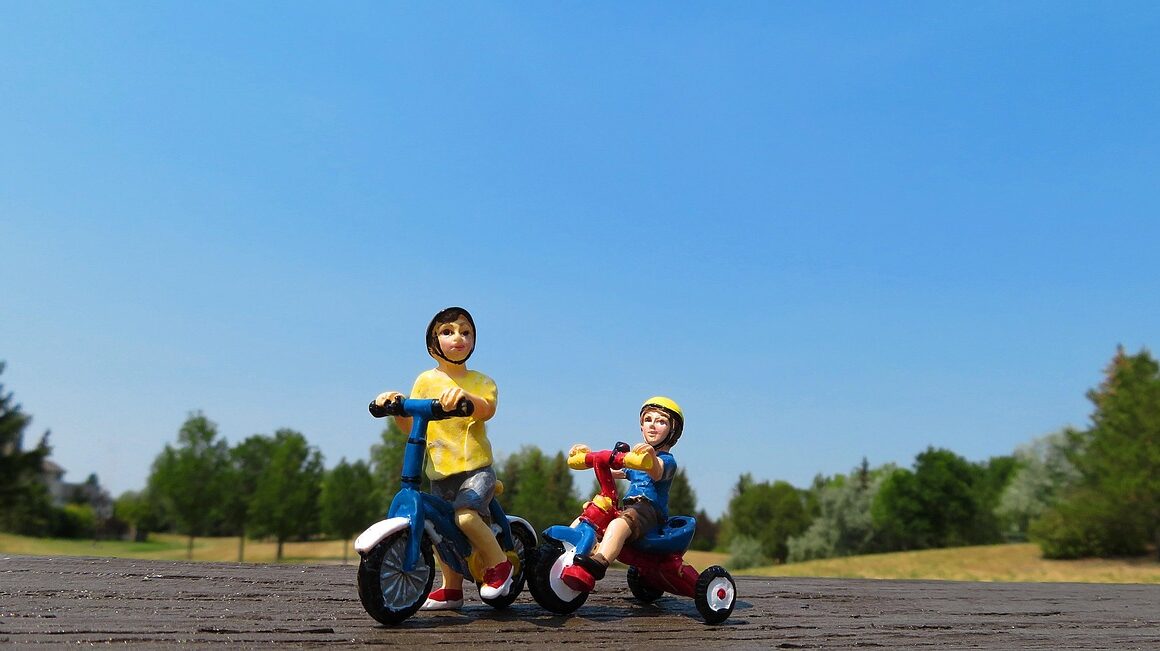Cycling Safety Tips and Balance Drills for Children
Cycling is an enjoyable activity for children that fosters both fitness and fun. However, ensuring their safety while riding is paramount. Parents should begin by selecting the right size bicycle for their child, as this significantly influences comfort and control. A child should be able to touch the ground with their feet while sitting on the saddle. Helmets are non-negotiable, as they protect the head from serious injuries. Make sure to choose a helmet that meets safety standards and fits securely. Additionally, teaching children the importance of signaling while turning can help prevent accidents. Children should be educated to always ride in designated bike lanes and obey traffic signals. Practicing in a safe, quiet area is beneficial before venturing onto busier roads. Moreover, a pre-ride bike check is essential; ensure the brakes work well, the tires are inflated, and the chain is lubricated. Finally, impress upon children to stay aware of their surroundings and avoid distractions like smartphones. By following these safety tips, children can enjoy cycling while minimizing risks, making it a delightful experience for the entire family.
Balance is a crucial skill for effective cycling, especially for young riders. A fun way to develop balance is through specific balance drills. One effective drill involves the use of a balance beam; this can be a wooden plank placed on the ground. The child can practice walking across the beam without falling, gradually increasing the challenge by narrowing the beam or adding obstacles. Another excellent activity is the ‘one-footed riding’ drill. This requires the child to ride a bicycle while lifting one foot off the pedal for a few seconds, then switching feet. This movement helps cultivate stability and strengthens core muscles. Cycling games can also enhance balance; for instance, playing follow-the-leader allows children to mirror balance-related maneuvers. Setting up small cones or markers teaches children to navigate while maintaining stability. Additionally, practicing slow riding can enhance their control and balance; the goal is to ride as slowly as possible without stopping. Smooth terrain with slight elevation changes is ideal for practicing maintaining balance and control. Introducing these exercises not only improves their cycling ability but elevates their confidence in handling the bicycle smoothly.
Importance of Coordination in Cycling
Coordination is another pivotal component when it comes to cycling for children. Good coordination enhances their ability to steer the bike effectively while maintaining balance. Engaging in activities that promote coordination along with balance can significantly boost a child’s cycling experience. Activities such as playing catch or rhythm-based games help improve hand-eye coordination. Setting aside time for these fun activities can yield substantial benefits when children return to their bicycles. Similarly, utilizing balance bikes allows young children to master the essential coordination needed for cycling. These bikes lack pedals, encouraging users to push their feet along the ground and focus on balance and steering. Once they feel confident, they can transition to traditional bicycles effortlessly. Parents should encourage children to explore different terrains, as navigating various surfaces can also enhance their coordination. Riding on grass, gravel, or asphalt introduces unique challenges and helps improve motor skills. Finally, regularly providing feedback on their techniques can help children refine their coordination and build a solid foundation for safe and enjoyable cycling adventures.
Incorporating games into cycling practice sessions can make learning essential skills enjoyable for children. Games that involve riding around cones, racing through obstacles, or timed challenges can create a sense of excitement. These games offer children the chance to practice turning, braking, and pedaling efficiently. Parents and guardians can organize friendly competitions, encouraging both skill-building and social interaction. For instance, the ‘Bike Tag’ game operates similarly to regular tag but requires players to stay on their bicycles. Such activities will help children connect fitness with fun, making the cycling experience more engaging. Additionally, teaching them to negotiate turns at higher speeds can be performed through various games. These activities encourage children to lean into turns and shift their weight as needed, thus improving their control. Furthermore, introducing team games fosters camaraderie among child cyclists, encouraging teamwork as they plot strategies and use communication. Games contribute significantly to building confidence in one’s cycling abilities while also showing kids that exercising can be enjoyable. This advancement can encourage lifelong physical activity habits that extend beyond cycling.
Safety Gear and Equipment for Kids
Choosing the right safety gear is an essential step for children engaging in cycling activities. A properly fitted helmet should be the priority, as it greatly reduces the risk of head injuries. Additionally, reflective gear and lights are crucial, especially for riding at dusk or in low-light conditions. Visibility increases the likelihood of being seen by drivers and other cyclists, thereby enhancing safety. Knee and elbow pads can provide extra protection against scrapes from falls, and children should be encouraged to wear them for added confidence. It’s also advisable to dress children in bright clothing to increase visibility on the road. Shoes should be chosen carefully, ensuring a good grip on the pedals and stability while riding. Gloves may also be beneficial as they provide an improved grip and protect the child’s hands during falls. Furthermore, ensuring that the bicycle is equipped with front and rear lights can significantly aid visibility. It’s crucial to teach children to check their gear before each ride to ensure everything fits correctly and functions well. Implementing these safety measures equips children with the confidence needed for a safe cycling experience.
Developing a routine for safe riding habits prepares children for real-world scenarios. Encouraging practices such as riding in a straight line, maintaining a safe distance from other cyclists, and signaling when turning can make a significant difference. Introduce children to the concept of ‘defensive cycling,’ which means being aware of their surroundings and anticipating the actions of others on the road. Role-playing various scenarios can be quite effective, allowing them to recognize potential hazards and practice decision-making in response. Discuss the importance of following traffic rules, such as stopping at stop signs and looking both ways before crossing intersections. Teach them about sharing pathways with pedestrians and other cyclists to ensure a smooth and respectful experience. Incorporating these lessons into routine cycling sessions establishes clear expectations for safety. Additionally, consider organizing group rides with adults nearby to ensure a safety net during practice sessions. Children will feel more comfortable when they know someone is watching over them, enhancing their focus on the skills they are developing. This preparation is critical for enjoyment and safety, fostering responsible cyclists who appreciate biking’s joy and freedom.
Conclusion: Empowering Young Cyclists
Empowering young cyclists through proper education and practice is vital as they embark on their cycling adventures. In teaching kids about safety and honing balance skills, we are not only equipping them with necessary skills but also instilling confidence. It’s important for parents to remain engaged in their kids’ experiences while cycling, offering guidance and encouragement. Enabling them to participate in balance drills and safety checks fosters responsibility and self-reliance. Additionally, incorporating games and fun activities keeps their interest alive while reinforcing important skills to keep them safe on their bikes. Promoting safe habits from a young age will help children establish lifelong patterns related to fitness and well-being. Cycling not only provides physical benefits but also valuable lessons about teamwork, coordination, and confidence. As children grow more adept at cycling, they will naturally explore more challenges, improving their skills further. Ultimately, creating a culture of safe and enjoyable cycling enables children to experience the freedom that comes from riding, fostering an appreciation that extends far beyond the activity. Encourage children to embrace their cycling adventures with joy while remembering to prioritize safety and balance.
As your child practices cycling, the skills they develop will have invaluable applications in many aspects of life. Encouraging children to ride regularly is an investment in their fitness and lays the groundwork for an active lifestyle. By making cycling both fun and safe, you enable them to build a foundation that supports their overall health. Regular cycling contributes significantly to cardiovascular fitness, muscle strength, and mental well-being, enabling children to feel good physically and emotionally. Ultimately, a well-rounded approach that includes safety awareness and balance drills not only enhances their cycling experience but fosters confidence on two wheels. By empowering children with skills and knowledge, you instill love and appreciation for the outdoors, encouraging exploration and adventure. Each cycling journey provides opportunities for growth, fun, and education. With your support and guidance, those little cyclists will find joy in cycling while developing important life skills. As their confidence grows, so will their excitement for new biking experiences and journey into fitness, paving the way for healthier choices in the future. So, ensure they are equipped with the right tools and perspectives to thrive on their cycling adventures.


